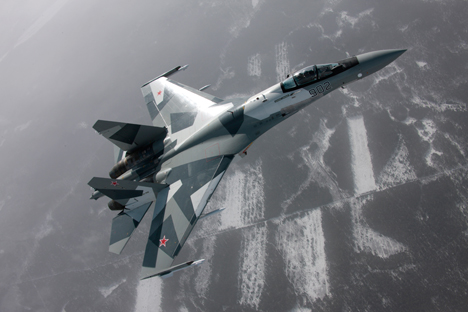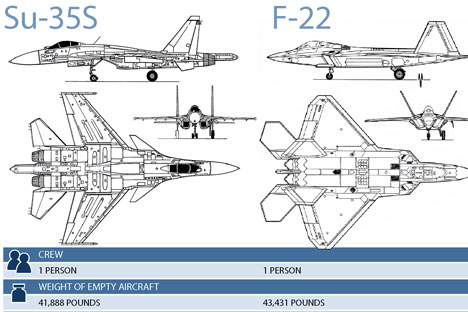Su-35S overtakes American F-22 in terms ‘intellect’

The Russian air force is due to receive 48 Su-35S aircraft before the end of 2015. Source: Sukhoi.org
The advanced, front-line aviation complex PAF FA (the T-50) is completing its compulsory test phases successfully. The fifth-generation fighter is expected to enter service with the military in 2017. Meanwhile, however, front-line units are already being equipped with an almost exact counterpart to this aircraft — the Su-35S multi-role fighter.
Along with creating the virtual fifth-generation fighter concept—from the very beginning it has been designed solely in digital form — the ready-made components of the future fighter were implemented and developed on the Su-35S platform.
As a result, the 4++ generation Su-35S was practically on par with the fifth-generation fighter across all characteristics (except stealth technology), right up to the moment it entered series production.
The Su-35S is capable of reaching speeds of up 1,490 miles per hour and has a range of up to 2,235 miles. It is equally reliable as a fighter, a long-range interceptor and a missile-carrying bomber.
Moreover, in terms of certain characteristics, the Su-35S has already overtaken the only fifth-generation fighter to enter service to date — the American F-22 Raptor. Thus, the Irbis radar-control system fitted to the Su-35S is able to detect an airborne target at a record distance of up to 250 miles and of tracking up to 30 targets and engaging 8 simultaneously.
The radar system on the F-22 is weaker: The maximum detection range is only 185 miles.
In addition to this, the Irbis provides the potential to actively detect and track up to four ground targets simultaneously. The Su-35S is also fitted with a navigation system capable of pinpointing the aircraft’s location and its movement parameters autonomously, without resorting to satellite navigation or communication with ground stations.
That is to say, if the GPS or GLONASS were switched off, the aircraft would not be “blinded.”
The Russian air force is due to receive 48 Su-35S aircraft before the end of 2015. In practical terms, this is 50 fifth-generation aircraft, as the Su35S is almost identical to the PAK FA in terms of the onboard electronics suite, control systems and armament.
Therefore, it will not prove difficult for pilots to convert to the classic fifth-generation fighter and its obligatory stealth technology: Any pilot who has adapted to the Su-35S can easily convert to the T-50. This means that the conversion to fifth-generation fighters does not start in 2017 — it is already happening now, in the Russian air force.
The ideology of the aircraft that will dominate the skies in the second half of the 21st century is being determined today. Whether these will be flying robots or classic, manned fighters with even more up-to-date electronics and new armament is not really important.
The main thing is that the Russian aircraft industry has a head start in developing a sixth-generation fighter. The quicker the Su-35S enters service with front-line units and the greater their numbers, the more successful work to create a new generation of fighter aircraft will be.
Click to enlarge the infographics.
All rights reserved by Rossiyskaya Gazeta.
Subscribe
to our newsletter!
Get the week's best stories straight to your inbox

